|
|
Point Cook Adapted from the article "Point Cook - The Birthplace of the Royal Australian Air Force" by P. A. Allen
The Royal Australian Air Force Base at Point Cook on the shore of Port Phillip Bay, 25 kms south-west of Melbourne is steeped in history and tradition. It was Australia's first military flying base, the nation's main pilot training base of World War II, and today is home of Headquarters Training Command (HQTC) and the RAAF Museum.
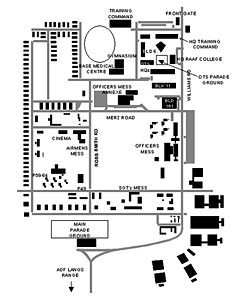 The Royal Australian Air Force Base at Point Cook, Victoria, Australia You may wish to download a larger copy of the map
Today it also houses for the RAAF units such as the School of Languages and RAAF College (encompassing the Officers' Training School). Although the drone of aircraft has become a familiar sound to the residents of the Shire of Werribee, in which the base is located, it was only in 1913 that Point Cook, a peaceful cow paddock, was chosen as the site for a military flying school. In 1836 HMS Rattlesnake sailed into Port Phillip Bay on a survey and charting voyage. Among the coastal features named at the time was Point Cooke, named after the First Mate, John M. Cooke. The 'e' has subsequently been dropped through common usage. On 17 January 1911, the Australian Military Board first considered aviation. A few days later, a cable was dispatched to the War Office for advice on the matter. In June of 1911, the High Commissioner was authorized to select two aviators and five flying machines. From the many applicants for the aviator positions, two men, H. Petre and E. Harrison, were selected. Petre embarked on the 'Omrah' which sailed from the United Kingdom on 6 December 1912 and arrived in Australia in January 1913. He was tasked with the selection of a site for an aviation school. Rejecting a site close to Duntroon in Canberra, he chose 734 acres of Mr. George Churnside's property which was subsequently purchased for approximately 6040 pounds. E. Harrison was appointed on 16 December 1912. He and two mechanics, Chester and Shoreland, departed England on the 'Otway' on 25 April 1913. Before departure, five aircraft had been ordered for use with the Australian Flying Corps. Two BE2a Biplanes, two Deperdussin monoplanes and one Bristol Boxkite were purchased for a total price of 3,528 pounds.
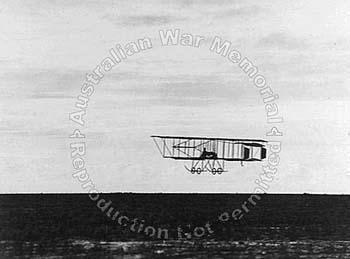 Bristol 'Boxkite', Central Flying School, Point Cook, Victoria, Australia, c.1914-15 Australian War Memorial Negative No. A04758
On arrival in Australia the aircraft were stored at Victoria Barracks in Melbourne before transfer to Point Cook in February 1914 when the first load of gear was delivered. The aircraft sadly needed attention; most of the fabric was mildewed and the engines rusted due to faulty packing. As a result of a comprehensive report submitted on the condition of those machines, all further imported aircraft arrived in a perfectly satisfactory manner.
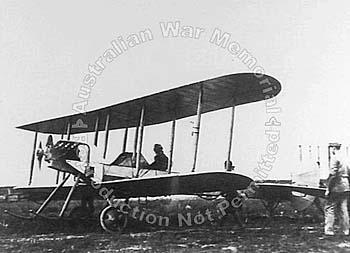 BE2a, Central Flying School, Point Cook, Victoria, Australia, c.1914-15 Australian War Memorial Negative No. A04547
The only accommodation available for the aircraft was a 40' by 40' Army hospital tent, which was found to be totally unsatisfactory. A tent however, which housed two BE2a machines was designed by Mr. Harrison and made in Melbourne. This tent was used for well over a year until the first section of a workshop and a pair of hangars was completed. The first test flight was made on the morning of 1 March 1914. That same afternoon Henry Petre carried away a telephone wire and crashed on of the Deperdussin aircraft. On that day Point Cook became the site of the first military flight and also the first crash.
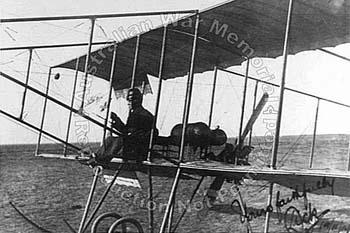 Richard (Dick) Williams, Central Flying School, Point Cook, Victoria, Australia, November 1914 Australian War Memorial Negative No. A04546
The first flying training course began with four members on 18 August 1914. Amongst the members of that course was R. Williams (later Air Marshal, KBE, CB, DSO and Chief of the Air Staff) and also a Captain T. W. White (later Group Captain, DFC and Minister of State for Air). With the outbreak of war, Point Cook naturally became the assembly point for the Australian Flying Corps personnel proceeding overseas. The first group to depart left Point Cook on 30 November 1914 for service with the Australian Expeditionary Force against German New Guinea. This unit was under the command of Lieutenant Eric Harrison. The unit was equipped with one BE2a Landplane and a Farman Seaplane. The aircraft were never uncased and the unit returned in February 1915. The next unit to form was the famous, yet ill-fated, Australian First Half Flight. It consisted of four officers and 41 other ranks under the command of Captain H.A. Petre and sailed from Melbourne during 1915 to fight in the Tigris Valley. Following departure of the Half Flight, the next unit to leave was No. 1 Squadron with 28 officers and 181 airmen on 16 March 1916. This squadron served in Egypt, and during that service Lieutenant F.H. McNamara, later Air Vice-Marshal, won the Victoria Cross for rescuing a comrade in the Sinai Desert under heavy enemy fire. He was the only Australian airman to win this decoration in World War I.
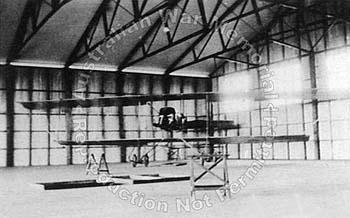 Maurice Farman 'Shorthorn', CFS7, Central Flying School, Point Cook, Victoria, Australia, c.1916-17 Australian War Memorial Negative No. A04635
Toward the end of 1916, No. 2 Squadron Australian Flying Corps commenced forming at Point Cook. The aircrew did not complete their training instruction but were sent to the United Kingdom, leaving on 25 October 1916. The third squadron, No. 4 Squadron, was quickly organised and dispatched on 17 January 1917. One of its members, Captain George Jones, joined the Australian Flying Corps as a mechanic and eventually rose to the rank of Air Vice-Marshal during World War II. He ultimately became the Chief of the Air Staff, and under his direction the RAAF Museum was formed. Both these squadrons fought in France. Altogether there were four squadrons of the Australian Flying Corps of the Australian Flying Corps, but No. 3 Squadron was recruited overseas.
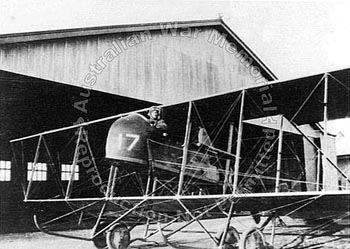 Maurice Farman 'Shorthorn', CFS17, Central Flying School, Point Cook, Victoria, Australia, c.1917 Australian War Memorial Negative No. A04618, Lt. A.N. Eedy Collection
During the war, Point Cook not only served as a flying training unit, but also as an assembly point for all AFC units going overseas. Altogether eight courses were conducted during the war. Out of nearly 100 officers starting, 36 were posted to squadrons before the end of their training, whilst only a small portion was ever suspended. At the end of World War I, Central Flying School at Point Cook as it was known then, remained the only base for the Flying Corps and was reduced to a very small unit. Flying was still carried out and there were some notable flights from Point Cook, one of them being the first flight across Australia. That flight from Point Cook to Darwin was carried out by Captain, later to be Air Vice-Marshal, H. N. Wrigley, CBE, DFC, AFC, and Sergeant, later to be Air Commodore, A.W. Murphy, DFC, AFC in a BE2E aircraft. The purpose of the flight was to find suitable landing grounds for Ross and Keith Smith in their Vickers Vimy on the famous flight from England to Australia in 1919. The first air-sea rescue flight was made from Point Cook when the schooner 'Amelia J' went missing in Bass Strait in September 1920. Captain Stutt and Sergeant Dalzell set out from Point Cook in a DH9A aircraft and were never seen again. Point Cook remained the only military air base within Australia until 1925, when the Royal Australian Air Force which was formed in 1921, expanded to Laverton (Victoria) and Richmond (New South Wales). In 1924 Wing Commander S. J. Goebel, later Air Vice-Marshal, DSO, CBE, DFC and Flight Lieutenant I. E. McIntyre, AFC left Point Cook in a Fairey 3 Float Plane to circumnavigate Australia in order to find out more about the coastline. The trip was made in 43 days, a total of 9,267 miles being flown. In 1926, Group Captain R. Williams, a member of the first training course, with Flight Lieutenant McIntyre and Sergeant Trist, left Point Cook in a DH5A Float Plane to gain knowledge of geography and flying conditions in the Pacific Islands, in order to be the first in the British possession in the Pacific. During that expedition, they flew more than 10000 miles and returned to Point Cook after an absence of nearly three months. Development proceeded slowly and was considerably retarded by the Depression of the early 1930s. The last unit to be established at Point Cook prior to the war was No. 10 Squadron, which was formed in July 1939 from a flight of a Seaplane Squadron of No. 1 Flying Training School and consisted of seven officers and 14 other ranks. The Seaplane Squadron was used for Naval co-operation as well as coastal surveys. It was Squadron Leader Hempel of this squadron in 1935, who left Point Cook in a Southhampton to survey the Darwin/Sydney section of the British Empire Air Mail route for an examination of seaplane mooring sites throughout Australia and New Guinea. His work was not completed until 1936. With the outbreak of war in September 1939, Point Cook became the composite training ground for the RAAF and the centre and hub of all training activities in the RAAF. The initiation of the Empire Training Scheme gave a further impetus to the activities of Point Cook and by the cessaytion of hostilities 2,700 pilots had graduated from the Station, many of whom won for themselves reputations as some of the world's finest fighter and bomber pilots. In all, there were 46 flying training courses carried out at Point Cook up to the year 1944. There were also approach training courses, Oxford conversion courses, operational training courses, service flying training instructor courses and elementary flying training instructor courses as well as navigation courses conducted at Point Cook. By June 1943, new concrete runways and drainage systems had been completed at Point Cook, and satellite aerodromes completed at Werribee, Little River and Lara had all been used. In the post-war period, RAAF Station Point Cook had continued to administer and control the activities of the Station until 15 June 1950, when headquarters Training Group was formed and assumed control until 1 April 1952. During the period of demobilization and the transition to peace time activities, many units were temporarily based at Point Cook until permanent facilities were established. No. 1 Aircraft Performance Unit, later known as Aircraft Research and Development Unit (ARDU), was located at Point Cook from 1946 until October 1948 when it moved to its (then) permanent base at Laverton. No. 1 Flight Training School, which originated in the early 1920s, and which was known during the war as No. 1 Service Flying Training School, moved back to Point Cook on 1 September 1947. Central Flying School (CFS) which originated during World War I returned to its home station towards the end of World War II, but only for a short period. In December 1947 CFS was transferred to East Sale, Victoria. Air Defence Headquarters, which was located in Melbourne during the war years, moved in nucleus to Point Cook on 28 February 1946, and finally disbanded there in December of that year. As the peace-time programme of the Station gradually evolved, new units were formed to assist in the efficient running and administration of RAAF Point Cook. The Base Squadron was formed on 15 June 1950. Its object was the maintenance of all domestic, medical and messing facilities on the Station and procurement of equipment and provisions. A maintenance squadron was formed on the same day and its objective was devoted to the care of aircraft on charge. The RAAF College was formed on 1 August 1947. Its sole function was the training of cadets, hitherto the function of No. 1 Flying Training School until 1940. The aim of the college was to provide cadets with theoretical and practical training essential to launch them on careers as permanent officers in the Royal Australian Air Force. On 1 January 1961, in keeping with the major Air Forces of the world, the college was renamed the Royal Australian Air Force Academy. With the approval and co-operation of the University of Melbourne, cadets entering the RAAF Academy successfully completed their flying and academic courses and graduated with the degree of Bachelor of Science or Bachelor of Engineering. In 1986 the Australian Defence Force Academy assumed the role of training these cadets. The RAAF Academy was renamed the RAAF College and retained responsibility for RAAF officer training through the Officer Training School, Air Force Studies School, External Studies and Basic Staff Schools. The Linguistic Section of No. 1 Engineering School, the forerunner of the School of Languages, transferred to Point Cook on 28 February 1946. On 7 January 1952, the Linguistics Section of the Station Headquarters ceased to function and formed into a separate unit. The Aviation Medical Section of Station Headquarters and the Medical Training Section of No. 6 RAAF Hospital from Laverton, were united at Point Cook and formed what we know as the School of Aviation Medicine. Aviation medicine covers all aspects of flying and associated ground activities and includes tropical service, survival techniques, hygiene, radiation and workshop hazards and flying clothing research. The School of Aviation Medicine is now located at RAAF Edinburgh. All six Antarctic flights have been formed and trained at Point Cook prior to leaving for their bases in the far south. In 1952 action was taken to establish a Museum at RAAF Point Cook, and now it has a fine collection of historic aircraft, uniforms, badges, weapons, military photographs, technical equipment, model aircraft and other memorabilia. The Museum also possesses an extensive collection of books, films and albums and technical publications which are used for aviation research. For the aircraft enthusiasts, the Museum has many historic aircraft on display, some of which are airworthy and used for special flying events. The RAAF Museum also provides facilities for the restoration of historic aircraft which will ultimately be displayed at the Museum. In the post-war years of Point Cook, 88 Women's Royal Australian Air Force recruit courses, 13 Service Police courses and 190 Pilot's courses have been conducted at the Base. Two notable events witnessed at the Base in post-war years were those involving Queen's Colours. In 1953, the Queen's Colour was handed by Laverton to Point Cook for custody. The Colours were prominently displayed when Her Majesty Queen Elizabeth II paid an official visit in March 1954. In 1981 the Queen's Colours were presented to No. 1 Flying Training School, Point Cook by the then Governor-General, Sir Zelman Cowan, AK, GCMG, GCVO, KStJ, QC The history of military aviation in Australia and of the RAAF is synonymous with the development of RAAF Point Cook and indeed all other RAAF Bases in Victoria. The numbers of airmen of different pursuits training in Victorian stations before, during and after the war bears testimony to the decision by the young London barrister H. Petre to select what was once a quiet cow paddock south-west of Melbourne for Australia's first venture into military aviation. Air Force Museum, RAAF Base Williams, Point Cook, VIC 3027 Australia. Recorded Info 61 3 92561443, fax 61 3 92561692 (25km SW of Melbourne)
|
© Copyright 1999 CTIE - All Rights Reserved - Caution |